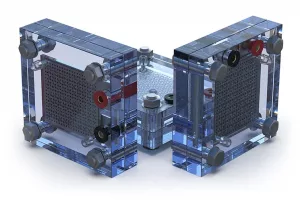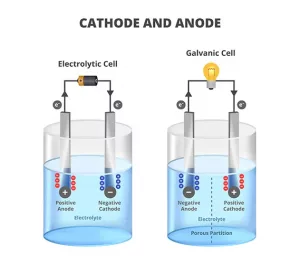Electrochemical Machining
 Electrochemical machining (ECM) is a method of removing metal by an electrochemical process.
Electrochemical machining (ECM) is a method of removing metal by an electrochemical process.
The electrochemical machining process is a function of electrochemistry: the branch of physical chemistry concerned with the relationship between electrical potential, as a measurable and quantitative phenomenon, and identifiable chemical change, with either electrical potential as an outcome of a particular chemical change, or vice versa.
In this article we will explain everything you need to know about the ECM process by covering the following main topics:
- Electrochemical Machining Process
- Electrochemical Deposition Process
- Material Removal
- Benefits of the ECM Process
- Drawbacks of the ECM Process
- Improved Quality with BF&S Manufacturing
Electrochemical Machining Process
In the electrochemical machining process, the way that material is removed from the work material is unique. The electrochemical reactions take place at the anode (work material) and the cathode (tool), as well as the surrounding electrolyte fluid. As the electrical current is applied across the electrode, ions move between the tool and the workpiece.
Repeated electrochemical grinding using conventional methods will inevitably break down the machine’s current density. Even a concave tool can accomplish an electrochemical or galvanic coating, a coating surface finish produced by the ECM process, with known strength and longevity. This improved electrical conductivity and overall machining accuracy.
Electrochemical Deposition Process
 Electrochemical deposition is a process where the metallic ion can become solid metal and deposit on the cathode surface if a sufficient amount of electric current passes through the electrolyte solution. The electrolyte contains charged ions, which form by dissolving a metallic salt in water.
Electrochemical deposition is a process where the metallic ion can become solid metal and deposit on the cathode surface if a sufficient amount of electric current passes through the electrolyte solution. The electrolyte contains charged ions, which form by dissolving a metallic salt in water.
A suitable electrolyte balance can be achieved by mechanical engineers utilizing the ECM process on workpiece material, thus reducing residual stresses on the turning of turbine blades or other workpiece acts.
Turbine blades and other complex shapes or exotic metals can also improve their current density and decrease tool wear beyond conventional methods by utilizing ECM.
Material Removal
Electrochemical machining (ECM) can be performed on any electrically conductive materials by forcing positive ions to move towards the tool, or positive terminal, and negative ions to move towards the workpiece, which then becomes the negative terminal.
This anodic reaction removes material and metal oxides, reducing mechanical stresses by improving the metal surface quality, leaving you with the desired shape of workpiece material for your mechanical engineering process. This also improves machining speed and machining process.
Benefits of the ECM Process
 The electrochemical machining (ECM) process has a number of benefits that make it a great choice for machining conductive workpiece materials.
The electrochemical machining (ECM) process has a number of benefits that make it a great choice for machining conductive workpiece materials.
Electrochemical machining produces an excellent material removal rate and workpiece surface finish once the material removal takes place.
Machine material(s) which has gone through the ECM process requires no further finishing because there is no contact between the tool and the workpiece and no forces of residual stress are produced. This reduces tool wear, streamlining manufacturing processes and saving your machine materials over time.
Less heat is generated in the electrochemical machining process because there is no contact and friction between tool and workpiece.
High metal removal rates are possible at the atomic level, and it’s even possible to cut small and intricate work in hard or unusual metals, such as titanium aluminides, or high nickel, cobalt, and rhenium alloys following material removal with the electrochemical machining (ECM) process.
Drawbacks of the ECM Process
 Despite the many benefits of the electrochemical machining material removal process, there are some drawbacks. If a saline or acidic electrolyte acts in such a way that it creates a buildup, it can increase the risk of corrosion for the tool, workpiece or equipment making direct contact more necessary than preferred.
Despite the many benefits of the electrochemical machining material removal process, there are some drawbacks. If a saline or acidic electrolyte acts in such a way that it creates a buildup, it can increase the risk of corrosion for the tool, workpiece or equipment making direct contact more necessary than preferred.
An electrochemical machining setup also requires a high initial investment from manufacturing engineers and high electrical running costs. Finally, only conductive materials can be machined. But electrochemical machining does add a very useful option for precise machining of some otherwise very difficult to machine materials.
Improved Quality with BF&S Manufacturing
BF&S is committed to exceeding our customers’ and interested parties’ expectations through certified employees and continuous improvement, providing a values-based environment in the context of the manufacturing organization, where our employees can meet their potential and thrive in an atmosphere of excellence. Our careful process of electrochemical machining allows us to deliver on that commitment again and again.
